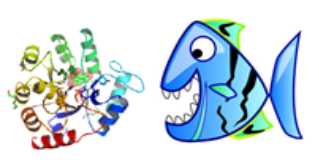
The skin mucus of fish plays an important role in providing a physical and biochemical barrier against pathogens in the aquatic environment.
The mucus is produced by the skin epithelium and contains a diversity of excreted proteins and metabolites. It is part of the innate immune response and its composition is greatly influenced by endogenous and exogenous factors. The composition of the mucus thus reflects the health status of the fish and provides a valuable, non-invasive source for the search for disease-related biomarkers. It is, however, challenging to obtain representative mucus samples because of the viscous and strongly adhesive nature of fish mucus. The development of reliable sampling and preparation methods is thus a prerequisite for the performance of every subsequent analysis. The broad measurement of mucus constituents by “Omics” technologies such as proteomics and metabolomics, accompanied by biostatistical data processing, can greatly advance the chance of identifying significant biomarkers for pathogen exposure, fish health and welfare.

Aims
The PromoFish project was initiated with the aim of establishing methods and workflows for salmon skin mucus sampling, sample preparation, targeted and untargeted metabolomics, untargeted proteomics and biostatistical data processing in the search for biomarkers of fish health and welfare.
Results
Three skin mucus sampling methods were evaluated by comparing the resulting proteome and metabolome profiles. Skin mucus was either scraped off, wiped off using medical wipes, or the mucus’ water phase was absorbed using by medical wipes. Following a filtration step, the obtained mucus samples were subjected to hydrophilic interaction chromatography coupled to high-resolution mass spectrometry.
The absorbed method was the gentlest method but had the restriction to mainly sample hydrophilic molecules. However, wiped mucus resulted in better protein and metabolite yields, delivering e.g. a large proteome of identifiable proteins, with only small contaminations by epithelial constituents. For future mucus research, the absorption method should be used if differentiation from the underlying epithelium is required, whereas the wiping method is recommended, when the protein and metabolite yields are and the contents of the outer epithelium are also of interest.
During the project, numerous biostatistical tools were tested, and an optimal workflow for the processing, evaluation and integration of large omics-data sets was established.
Publications
- Ivanova L, Tartor H, Grove S, Kristoffersen AB, Uhlig S. Workflow for the targeted and untargeted detection of small metabolites in fish skin mucus. Fishes 2018, 3, 21–34.
- Fæste, C.K.; Tartor, H.; Moen, A.; Kristoffersen, A.B.; Dhanasiri, A.K.S.; Anonsen, J.H.; Furmanek, T.; Grove, S. Proteomic profiling of salmon skin mucus for the comparison of sampling methods. J Chrom B 2020, 1138, 121965.